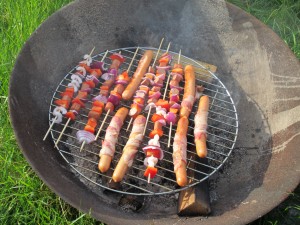
Pølser i svøb and shishkebabber on the grill… 🙂
Parallel to the sweet strawberry season runs the hot grill season. Real men need kød (meat) – or so the joke goes. (Of course, there are plenty of vegetarer in Denmark too!) Nonetheless, firing up the grill has become something of an annual intelligence test for many family fathers…
For thousands of years, Danes have been placing a rist (gridiron) above a bål (fire) in order to prepare meat and fish for eating. During the last fifty years or so, the grill seems to have been imported from the US (the famous webergrill was launched in 1952). In a small garden, it is a lot handier to have an open ”box” for your kul (coals) than keeping an entire fireplace!
Although the word grill has come to Danish from English, it is pronounced with a Danish R and inflected like a common Danish noun: 1 grill, 2 griller. If you wish at riste (to roast) something on a grill, there’s a nice verb for that: at grille (to grill).
Once your coals are shining with hot, orange gløder (glows), the time has come to put on some food. An all-time Danish favourite is pølse/r (sausage/s). A pølse i svøb is a sausage in a wrapping, like for instance a piece of crispy bacon. (Yummy!) Then there are the traditional kotelet/ter (cutlet/s, chop/s), which usually consist of svinekød (pork) or oksekød (beef). Even fisk like makrel (mackerel) and laks (salmon) can be grilled with great success, even if that’s not so common among the majority of meat-loving Danes…
For the vegetarians there are many options too. Almost anything goes – from jorbær (strawberries) to melon to champignon [SHAMP-ing-yong]. Majskolbe/r (corn cob/s) are a modern classic.
Outdoor grilling is loved by many Danes, as it is a great way of combining leisure and eating. Families can be together in an informal way – the kids playing on the lawn while the food is being prepared. Friends can take their time discussing the latest gossip over a bottle of vin or a few cans of øl.
Happy grilling!





